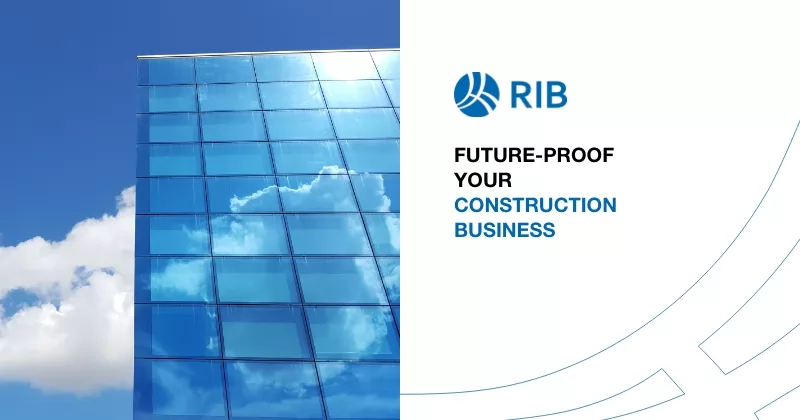5 mins read
Leading Solution Reduces The Complexity Of Embodied Carbon Measurement In Construction

June 2022. RIB CCS / EMBODIED CARBON IN CONSTRUCTION
As the rally cry for countries to significantly reduce their carbon emissions intensifies, the pressure is on governments and industries to take more definitive steps towards meeting the Paris Agreement’s 2050 net zero goal.
While most countries have committed to the agreement’s goal of limiting global warming to below 2 degrees Celsius above pre-industrial levels (preferably to 1.5 degrees Celsius), there is much to be done, especially for the built environment, which is responsible for generating 39% of global greenhouse gases and accounts for 36% of the world’s energy demand.
Within this milieu, RIB Software – a multinational that provides innovative technology solutions to the architecture, engineering and construction (AEC) industry – in the latest release of its iTWO costX solution, has introduced an embodied carbon calculator – allowing industry professionals to quantify, measure, report on and compare embodied carbon across a project’s lifecycle. It is the first solution globally that integrates embodied carbon accounting with cost estimating.
René Wolf, CEO of RIB Software, says until now, the sector has been particularly hard-pressed to find solutions. “And, of course, the industry has to deal with the double-whammy of ‘operational’ and ‘embodied’ carbon emissions for every construction project it undertakes.”
While operational carbon refers to the CO2e emitted during a building’s operation, embodied carbon refers to the CO2e that is emitted during the manufacture, transport, installation and disposal of materials such as concrete, steel and glass of the same building.
Wolf says with increased focus on reducing carbon from processes and materials, as well as waste and rework, the AEC industry is being compelled to explore choices of materials and solutions such as prefab more seriously. “Globally, governments are introducing taxes and requirements for reporting and accounting of carbon. This has a major impact on operating expenses of buildings and end-users (clients), contractors and the entire AEC network of stakeholders throughout the value chain must tackle this together.”
This means the measurement of embodied carbon has come under greater scrutiny than ever before. A major challenge worldwide is that the data available for the management of embodied carbon has not been where it should be, and its integrity has been questionable.
He says contractors around the globe have been grappling with either an absence of data or – where the data is available – it not being in a format that is user-friendly. “Until recently, contractors have had to flush out data from various databases across the globe, an onerous and often inaccurate task.”
On a positive note, the United Nations is trying to standardise carbon reporting and the processes around how it is acquired, managed, and made available for use.
“The forerunners in this are the United Kingdom (UK) and United States (US). While the UK is driving the establishment of carbon accounting standards for the UN to administer globally, non-profit organisation, Building Transparency, in the US has established the Embodied Carbon in Construction Calculator (EC3), a database made up of digital, third-party verified Environmental Product Declarations (EPDs), which can be used to conduct sustainability benchmarking and assessments,” adds Wolf.
Suppliers of products such as concrete, steel or glass are required to produce an EPD. EPDs are governed by ISO standards and need to be vetted for their authenticity by local governance bodies in the countries they are manufactured in. This is to make sure data is credible and has the right integrity to be used for carbon monitoring.
The database allows contractors to drill down to products manufactured and supplied in their neck of the woods and find their carbon values, allowing them to accurately monitor and report on the carbon footprints of their projects.
RIB Software recently partnered with Building Transparency to help with the upkeep of the EC3 database and find ways to create even greater efficiencies for the industry.
“We believe EC3 offers the industry a viable solution to measuring the embodied carbon footprints of various projects, and the more EPDs we can upload from different product manufacturers around the world, the easier it will be for contractors to not only track their carbon footprints, but to lessen them or make trade-offs to reduce their impact,” notes Wolf.
To further enable this, EC3 rates can be directly imported into iTWO costX and used to enable better design and procurement decisions, factoring in cost, time and carbon to mitigate and perhaps even, one day, eliminate embodied carbon used across the life of a building.
Wolf notes that RIB has been at the forefront of innovation in the construction industry for more than 60 years. “We believe it is vital to not only adopt the latest sustainable technology and construction methodologies, but to also improve the energy efficiency of existing buildings and reduce the carbon footprints of new buildings.
“If we are to build a sustainable future, the construction sector must lead the way forward. While we may be part of the problem, the good news is we can also be part the solution by empowering contractors with access to data that can help them make decisions that have more sustainable outcomes for a better tomorrow.
“Continued development of our solutions will enable better design and procurement decisions that factor in cost, time and sustainability to mitigate and, ultimately, eliminate embodied carbon produced throughout the life of a building. With these new models of collaborative development – powered by connected data – our goal is to cut greenhouse gas emissions dramatically in less than a generation,” concludes Wolf.
Most Recent
5 mins read
6 mins read
7 mins read
3 mins read
News Categories

E-BOOK











